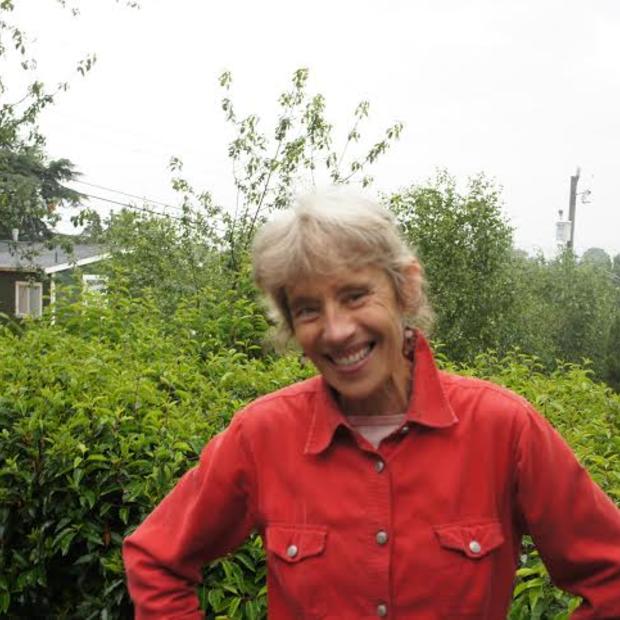As spring turns a warm corner, there’s no better place to experience it than a wetland, alive with swallows and the chorus of frogs. One wetland, once the former “Naval Air Station Seattle at Sand Point,” is about metamorphosis — of both creatures and place.
Click on the audio player above or here to listen.
Miriam Preus knows the wetlands at Magnuson Park very well. A wetland gardener, she’s the one who maintains the marsh ponds and frog ponds where once there was a naval air station. “My greatest joy here is that it takes more imagination to imagine this site as a jet runway than it does to imagine a wetland being on the site,” she says.
Preus takes a break from thinning cattails — they jeopardize biodiversity, she says.
Nearby barn swallows and blue violet swallows, recent arrivals from South America , outfly raptors on the hunt. Their calls mingle with frogs and other wildlife who find the wetlands a perfect breeding ground in spring and a refuge all year long.
“There’s a native frog population that’s just been exploding now that we’ve created great habitat," Preus says. "There’s dozens of egg masses in most of the ponds and in a few more weeks we’ll have tadpoles galore.”
The frogs, Pacific Chorus frogs, lived here when there were peat bogs and a lake named Mud, before the navy air station was built in the 1930’s. Now they begin breeding around Valentine’s Day and lay their eggs on thin stemmed vegetation standing in water.
The water level must be stable, explains Dyanne Sheldon, a restoration ecologist who helped make this wetland project happen. “It can’t be fluctuating up and down. They are particular about the diameter of the vegetation and the depth of water.” Once the eggs transition from tadpoles to frogs they require upland habitat, says Sheldon, forest and shrubs.
“That’s why there’s so much buffer that’s been planted here, because we’re trying to meet the full cycle of that particular species.”
The full cycle of these wetlands — some with deep water, others like mud flats — is dependent on its links with forests to the north, south, and west of the bog.
“This is not a restoration. It’s a creation. We’re creating a system that has not been here before,” says Guy Michaelson, landscape architect for the project. “It’s a natural system but it’s very unnatural. This is as engineered as the runway that once ran across the site.”
And it’s been engineered, says Michaelson, to get maximum habitat value out of the ponds and vegetation and welcome as many species as possible — humans and wildlife, native and migrant species.
On a rainy day Michaelson shows off an emergent wetland with plants like creeping spike rush and heart stemmed bulrush. “So what’s great is we have this vegetation ring," he says. "But then, when the water goes away, we get mud and little mud flats which are critical for certain bird species.”
The hydrology of the wetlands is supported by a sports field to the north. Both were designed to co-exist as a unique ecosystem package. Sand and gravel were laid underneath the sports fields to mimic the forest floor and absorb rain and stormwater run off from roads and hard surfaces. “And long after that storm is past the water continues to percolate out of these fields.”
On the other side of the sports field, the wetlands receive even more support. Beneath a massive Atlas Cedar in Magnusson Park’s historic district, volunteers plant ferns to prevent erosion. Emily Bishton is the park’s lead nature educator. “Water quality is one of the main reasons we’re doing this project is to keep our soil from washing down the storm drains and into the wetlands and eventually into Lake Washington.”
But there’s more to this watery web of interconnected habitats. Inside the community center it’s Celebrate Urban Nature day and wetland water and frogs are under intense scrutiny. Five year old Jonah examines what looks like a lump of jello.
“All the frog eggs are really gooey," he explains of the amorphous blob. "It grows into a tadpole and then it turns into a frog, but it didn’t lose its tail yet.”
Back outside, wetland gardener Miriam Preus, says the metamorphosis of frogs will last until mid-May or June. Then it’s time for duckling season. “You’ll see trains of ducklings in the ponds and once I even saw a coyote trailing along the shorelines behind the ducklings — just waiting.”
With fourteen acres of wetlands exploding with plants and animals, the coyote should be able to co-exist. This is urban nature and spring is in full bloom.



